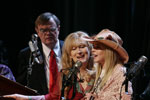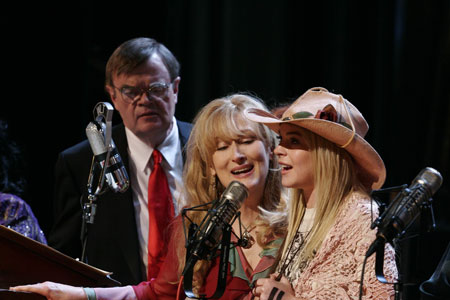A Prairie Home Companion
 I wanted to start this review by writing about Robert Altman and the provocative films he has made throughout several decades, but as I’m no advocate of so-called Auteur Theory, I will not discuss “A Prairie Home Companion” in context of his body of work. Instead, I will only say that it is an exception and not necessarily in a good way. I thought I might appreciate this film more because I live in the Minneapolis-St. Paul Metro Area, from…
I wanted to start this review by writing about Robert Altman and the provocative films he has made throughout several decades, but as I’m no advocate of so-called Auteur Theory, I will not discuss “A Prairie Home Companion” in context of his body of work. Instead, I will only say that it is an exception and not necessarily in a good way. I thought I might appreciate this film more because I live in the Minneapolis-St. Paul Metro Area, from…

Photo by Melinda Sue Gordon.
I wanted to start this review by writing about Robert Altman and the provocative films he has made throughout several decades, but as I’m no advocate of so-called Auteur Theory, I will not discuss “A Prairie Home Companion” in context of his body of work. Instead, I will only say that it is an exception and not necessarily in a good way. I thought I might appreciate this film more because I live in the Minneapolis-St. Paul Metro Area, from which Garrison Keillor’s radio show is based. Some of the radio show performers were on hand for the screening, but I’ll come back to that later. Instead of appreciating the film, I found that my residence in Minnesota of the past twelve years has only made me resent its myriad clichés—the kind only a Minnesotan would recognize.
The audience, however, seemed rather puzzled—as if they were expecting a simple and entertaining film and instead got a plodding parable about death wrapped in the occasional, colloquial humor. The story seems to be about Keillor and his radio show which features, among others, two singing duos—sisters Yolanda (Meryl Streep) and Rhonda Johnson (Lily Tomlin) and Dusty (Woody Harrelson) and Lefty (John C. Reilly), two cowboys loaded with dirty jokes. Where it begins is where every film about the Twin Cities inexorably leads no matter where in the entire metro area it may be based. The aptly named private detective turned security supervisor Guy Noir (Kevin Kline effecting Sam Spade) introduces himself from, as I warned you, Mickey’s Diner in St. Paul—a dining car whose repeated appearance in Minneapolis-based films has become a running joke here in the same fashion as Buckingham Fountain in Chicago or the U.S. Bank Tower in Los Angeles. Noir informs us that the radio show, “A Prairie Home Companion,” in its final performance at the Fitzgerald Theatre, has “been on the air since Jesus was in the the third grade.” Kline’s presence brings a lightness of foot to the character which at times seems entirely out of place with the arduous pace and brooding temperance of the majority of the film.
The story is more or less about Lola (Lindsay Lohan), a gaunt young girl with a morbid outlook on life. She sits backstage, wallowing in her solitude, writing nothing but songs about suicide. I don’t think she’s one of those teenagers who actually plans to go through with it. Lola, whose parents met in a diner in Oshkosh, Wisconsin, and shortly thereafter conceived her, is the kind of girl who embraces the idea of death because she is too young and too innocent to yet understand from where others derive value in life. Enter an enigmatic figure in a white coat, played by Virginia Madsen. Without spoiling who she is, I’ll say that her purpose is to bring some meaning and perspective into the lives of several people, including Lola. We see Madsen’s character weave in and out of scenes just as fluidly in the foreground as she does when in the background. In one instance, the woman meanders behind the stage set—you can see her through windows of a fabricated house exterior—while Noir attempts to follow her out on stage. Something baffling is going on here, though. You want to observe the solemnity of Madsen’s movement through the frame, which is echoed by the camera’s constant and watchful stroll through each scene, but at the same time you’re pushed to laugh at Kline’s antics which are precisely timed and well-conceived in relation to how a real person as preposterous as Guy Noir might act in just this kind of situation.
When the story wants to ruminate directly on death, including the impending death of the show (the Fitzgerald is being purchased by investors represented by the Axeman, played by Tommy Lee Jones), it becomes trite and boring. However, and this may or may not have been Altman’s intent, the movie’s most effective when it demonstrates to us the way such an emotionally-linked event influences those around the one who dies—the identity I won’t reveal. His death is a MacGuffin here. What’s important is the humanity elicited from the other characters. The Johnson sisters reminisce about old friends that have come and gone. Keillor tells stories to the mysterious woman… stories so dry they suck the life out of the audience. It would be ironic were it not for the fact that the peculiarity of his anecdotes didn’t provoke the film’s best punchline. Lola takes this all in and when Keillor, for reasons that seem unbelievable (at least to me), refuses to eulogize the man of whose death they’ve just been informed, she turns about and doubts the cast’s appreciation for the deceased.
Unfortunately, the film is so busy coddling itself in colloquial humor and Keillor’s conjured up diatribes (he tells at least two or three different stories about what made him go into radio) that, from one Minnesotan to you, isn’t funny in it’s own right. The humor depends largely on whether or not you’ve been a fan of the original show. And if that qualifies as universal humor, then the mere metion of Daleks should send every one of my readers into hysterics. But I guarantee you at least a few of my readers aren’t Dr. Who fans.
I have never understood why some find the overabundant stereotype of the Muddling midwestern story-spinner more than just oddly charming. “A Prairie Home Companion” is not some product relegated merely to history books but a living piece of history. The first live show was held in July of 1976 at the Janet Wallace Auditorium of Macalester College. If its charm is really something that can be appreciated beyond the Minnesota-isms (lutefisk jokes and all), and by more than just puritanical hicks who love sexual jokes but only as long as they’re laced in colorful metaphors that, ironically, too easily betray the intended meaning to the audience anyway, then why not a documentary?
What was the purpose behind relegating show mainstays Tim Russell and Sue Scott, both of whom were present at the Minneapolis screening, to backdrop roles, replacing everyone with big headliners like Streep (who previously usurped the lead in “Plenty” based on and intended for Kate Nelligan) other than marketing considerations? It seems only because Jearlyn Steele was featured in just a peripheral role, and not a leading role, in this film that she was afforded the opportunity to play herself. Odd, then, that the director who roasted Hollywood on a spit in 1992’s devlishly brilliant The Player should produce a star-promotion engine—the kind of “little” film the big names do every now and then to attempt to retain some credibility in between shlock projects.
I would have been fascinated by a documentary behind the lives of the real players in the radio show. The show itself might be funnier if one were to listen to or watch it directly, and especially in the live stage theatre where the energy of the audience is like a conductive force. Seeing it on a screen, an audience still feels somewhat detached. Given that, it certainly would have proved to make better material for a documentary. Even those not necessarily finding the radio show’s content very entertaining might take interest in the ways in which its participants have given something of themselves and received many intangibles in return from their involvement in the production.
A Prairie Home Companion • Dolby® Digital surround sound in select theatres • Aspect Ratio: 2.35:1 • Running Time: 105 minutes • MPAA Rating: PG-13 for risque humor. • Distributed by Picturehouse